
| ||||
|---|---|---|---|---|
 |
 |
 |
 |
 |



























| ||||
|---|---|---|---|---|
 |
 |
 |
 |
 |


























Bell P-39N Airacobra
United States — World War II single-engine single-seat fighter
Archive Photos
1943 Bell P-39N Airacobra (AF 42-8740, N81575) at the Yanks Air Museum, Chino, California
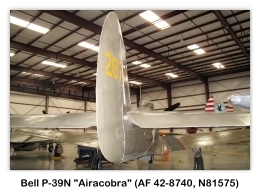
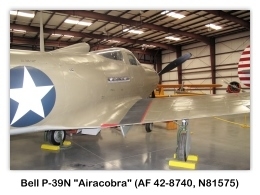
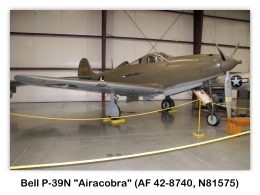

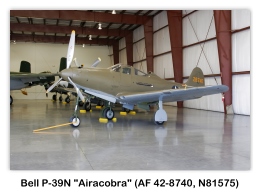
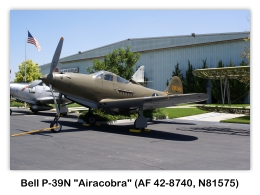
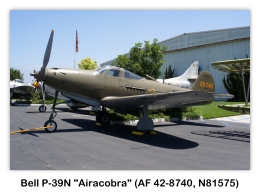
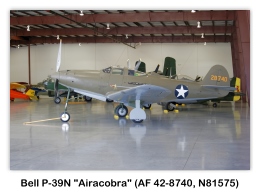
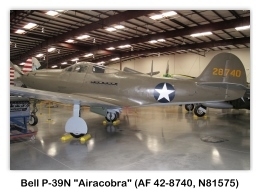
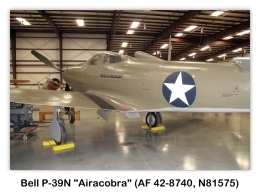
Bell P-39N-5-BE Airacobra (AF 42-19027) at the Planes of Fame Air Museum, Chino, CA (Photos by John A. Shupek)



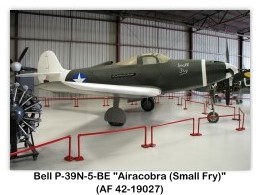


Overview
The Bell P-39 Airacobra was one of the principal American fighter aircraft in service at the start of World War II. Although its mid-engine placement was innovative, the P-39 design was handicapped by the lack of an efficient turbo-supercharger, limiting it to low-altitude work, although the type was used with great success by the Soviet Air Force. In the P-39, Soviet pilots scored the highest number of individual kills attributed to any U.S. fighter type. Together with the derivative P-63 KingCobra, these aircraft would be the most successful mass-produced, fixed-wing aircraft manufactured by Bell.
Design and Development
In 1937, the United States Army Air Corps issued a specification for a new fighter via Circular Proposal X-608. It was a request for a high-altitude interceptor aircraft having "the tactical mission of interception and attack of hostile aircraft at high altitude". Specifications called for a maximum Airspeed of at least 360 miles per hour (580 km/h) at altitude, and a climb to 20,000 ft (6,100 m) within 6 minutes; the toughest set of specifications USAAC had presented to that date. Other competing designs included the Curtiss P-40, an outgrowth of a previous design, and the Lockheed P-38, which utilized a complex Twin-engine twin boom configuration. Although Bell’s limited fighter design work had previously resulted in the unusual Bell YFM-1 Airacuda, the Model 12 proposal adopted an equally original configuration with an Allison V-12 engine mounted in the middle of the fuselage, just behind the cockpit, and a propeller driven by a shaft passing beneath the pilot’s feet under the cockpit floor.
The main purpose of this configuration was to free up space for the heavy main armament, a 37 mm Oldsmobile T9 cannon firing through the center of the propeller hub for optimum accuracy and stability when firing. In fact, the entire design was made to accommodate this gun in the aircraft. This happened because H.M. Poyer, designer for project leader Robert Woods, was impressed by the power of this weapon and he pressed for its incorporation though the original concept had been a 20-25 mm cannon mounted in a conventional manner in the nose. This was unusual, because fighters had previously been designed around an engine, not a weapon system. Although devastating when it worked, the T9 had very limited ammunition, a low rate of fire, and was prone to jamming.
A secondary benefit of the mid-engine arrangement was to create a smooth and streamlined nose profile. The weight distribution necessitated a tricycle undercarriage, a first among American fighters, concurrent with the Lockheed XP-38. Entry to the cockpit was through side doors (mounted on both sides of the cockpit) rather than a sliding canopy. Its unusual engine location and the long drive-shaft caused some pilot concern at first, but experience showed this was no more of a hazard in a crash landing than with an engine located forward of the cockpit. There were no problems with prop-shaft failure.
As originally designed, the XP-39 had a turbocharger with a scoop on the left side of the fuselage; both were deleted for production. The production P-39 retained a single-stage, single-speed supercharger with a critical altitude (above which performance declined) of about 12,000 ft.
The XP-39 made her maiden flight on 6 April 1938 at Wright Field, Ohio, achieving 390 mph at 20,000 ft. (630 km/h at 6,100 m), reaching this altitude in only five minutes. The Army ordered twelve YP-39s (with only a single-stage, single-speed supercharger) for service evaluation and one YP-39A. After these trials were complete, which resulted in detail changes including deletion of the external radiator, and on advice from NACA, the prototype was modified as the XP-39B; after demonstrating a performance improvement, the 13 YP-39s were completed to this standard, adding two .30 cal. (7.62 mm) MG to the two existing .50 cals. Lacking armor or self-sealing fuel tanks, the prototype was 900 kg lighter than the production fighters.
After completing service trials, and originally designated P-45, a first order for 80 aircraft was placed 10 August 1939; the designation would revert back to P-39 before deliveries began.
Technical Details
The P-39 was an all-metal, low-wing, single-engine fighter, with tricycle undercarriage incorporating a very streamlined and aerodynamically efficient design.
The Airacobra was conceived as a "weapons system" design with the T9 cannon in mind. This weapon fired a 1.3 lb. (610 g) projectile capable of piercing .8" (2 cm) of armor at 500 yards (450 m) with armor piercing rounds. The complete armament fit as designed consisted of the T9 with a pair of Browning M2 .50" (12.7 mm) machine guns mounted in the nose. This would change to two .50s and two .30s in the XP-39B (P-39C, Model 13, the first 20 delivered) and 2 × 0.50 and 4 × 0.30 (all four in the wings) in the P-39D (Model 15), which also introduced self-sealing tanks and shackles (and piping) for a 500 lb. (227 kg) bomb or drop tank. The engine was placed behind the cockpit, so pilots often referred to this as "Allison armor." A long transmission tunnel passed through the fuselage, under the cockpit, and was linked to the three-bladed propeller. The radiator was located in the fuselage.
In September 1940, Britain ordered 386 P-39Ds (Model 14), with a 20mm Hispano-Suiza HS.404 and six .303 (7.7 mm), instead of a 37 mm and six 0.30 calibers. The RAF eventually ordered a total of 675 P-39s. However, after the first Airacobras arrived at 601 Squadron RAF in September 1941, they were promptly recognized as having an inadequate rate of climb and performance at altitude for Western European conditions. Only 80 were adopted, all of them with 601 Squadron. Britain transferred about 200 P-39s to the Soviet Union.
Another 200 examples intended for the RAF were taken up by the USAAF after the attack on Pearl Harbor as the P-400, and were sent to the Fifth Air Force in Australia, for service in the South West Pacific Theater.
Because of the unconventional layout, there was no space in the fuselage to place a fuel tank. Although drop tanks were implemented to extend its range, the standard fuel load was carried in the wings, with the result that the P-39 was limited to short range tactical strikes.
A heavy structure, and around 265 lbs (120 kg) of armor were characteristic of this aircraft as well. The production P-39s heavier weight combined with the Allison engine having only a single-stage, single-speed supercharger, limited the high-altitude capabilities of the fighter. The P-39s altitude performance was markedly inferior to the contemporary European fighters and, as a result, the first USAAF fighter units in the European Theater were equipped with the Spitfire V. However, the P-39Ds roll rate was 75 degrees per second at 235 mph (378 km/h)- better than the A6M2, F4F, F6F, or P-38 up to 265 mph (426 km/h).
Above the supercharger’s critical altitude of about 12,000 ft, the P-39’s performance dropped off rapidly. This limited its usefulness in traditional fighter missions in Europe as well as in the Pacific, where it was not uncommon for Japanese bombers to attack at altitudes above the P-39’s operational ceiling (which in the tropical hot air inevitably was lower than in moderate climates).
The weight distribution of the P-39 supposedly is the reason for its tendency to enter a dangerous flat spin — a characteristic Soviet test pilots were able to demonstrate to the skeptical manufacturer who had been unable to reproduce the effect. After extensive tests, it was determined the spin could only be induced if the plane was improperly loaded, with no ammunition in the front compartment. The flight manual specifically noted a need to ballast the front ammunition compartment with the appropriate weight of shell casings to achieve a reasonable center of gravity. High speed controls were light thus high speed turns and pull-outs were possible although the P-39 had to be held in a dive since it tended to level out, reminiscent of the Spitfire. Recommended dive speed limit (Vne) was 475 mph (764 km/h) for the P-39.
The rear-mounted engine made the aircraft ideal for ground attack since fire would be coming from the front-bottom quarter and was less likely to hit the engine and its cooling systems. However, the arrangement proved to be very vulnerable to attacks from above and behind and nearly any hit on the fuselage from an attacking enemy fighter was virtually guaranteed to disable the cooling system and lead to the prompt demise of the engine and thus the airplane. Coupled with lack of high-altitude performance, the Airacobra was extremely vulnerable to any enemy fighter with decent high altitude performance.
By the time of the Pearl Harbor attack, nearly 600 had been built.
When P-39 production ended in August 1944, Bell had built 9,558 Airacobras, of which 4,773 (mostly -39N and -39Q) were sent to the Soviet Union through the Lend-Lease program. There were numerous minor variations in engine, propeller, and armament, but no major structural changes in production types, excepting a few two-seat TP-39F and RP-39Q trainers. In addition, seven went to the U.S. Navy as radio-controlled drones.
Trials of a laminar flow wing (in the XP-39E) and Continental IV-1430 engine (the P-76) were unsuccessful. The mid-engine, gun-through-hub concept was developed further in the Bell P-63 KingCobra.
A naval version with tail-dragger landing gear, the XFL-1 Airabonita, was ordered as a competitor to the Vought F4U Corsair and Grumman XF5F Skyrocket. It first flew 13 May 1940, but after a troublesome and protracted development and testing period, it was rejected.
Operational History
The Airacobra saw combat throughout the world, particularly in the Southwest Pacific, Mediterranean and Russian theaters. Because its engine was not equipped with a supercharger, the P-39 performed best below 17,000 feet (5,200 m) altitude. It often was used at lower altitudes for such missions as ground strafing. Russian pilots appreciated the cannon-armed P-39 for its ground attack capability.
United Kingdom
In 1940, the British Direct Purchase Commission in the US was looking for combat aircraft; they ordered 675 of the export version Bell Model 14 as the "Caribou" on the strength of the company’s representations on 13 April 1940. The performance of the Bell P-39 prototype and 13 test aircraft which were able to achieve a speed of 390 mph (630 km/h) at altitude was due to the installation of turbo-supercharging. The British armament was 0.50-inch machine guns in the fuselage, and four 0.30-inch machine guns in the wings, the 37 mm gun was replaced by a 20mm Hispano-Suiza.
The British export models were renamed "Airacobra" in 1941. A further 150 were specified for delivery under Lend-lease in 1941 but these were not supplied. The Royal Air Force (RAF) took delivery in mid 1941 and found that actual performance of the non-turbo-supercharged production aircraft differed markedly from what they were expecting. In some areas, the Airacobra was inferior to existing aircraft such as the Hawker Hurricane and Supermarine Spitfire and its performance at altitude suffered drastically. On the other hand it was considered effective for low level fighter and ground attack work. Problems with gun and exhaust flash suppression and compass were fixable.
No. 601 Squadron RAF was the only British unit to use the Airacobra operationally, receiving their first two examples on 6 August 1941. On 9 October, four Airacobra attacked enemy barges near Dunkirk, in the type’s only operational action with the RAF. The squadron continued to train with the Airacobra during the winter, but in March 1942, it re-equipped with Supermarine Spitfires.
The Airacobras already in the UK, along with the remainder of the first batch being built in the US, were sent to the Soviet Air force, the sole exception being AH574, which was passed to the Royal Navy and used for experimental work, including the first carrier landing by a tricycle undercarriage aircraft on HMS Pretoria Castle, until it was scrapped on the recommendation of a visiting Bell test pilot in March 1946.
United States
The United States requisitioned 200 of the next part of the order as the P-400. The P-400 designation came from advertised top speed of 400 mph (644 km/h). After Pearl Harbor, the P-400 was deployed to training units, but some saw combat in the Southwest Pacific including with the Cactus Air Force in the Battle of Guadalcanal. It often proved deadly in ground attacks on Japanese forces trying to retake Henderson Field. Guns salvaged from P-39s were sometimes fitted to Navy PT boats to increase firepower.
From September to November 1942 pilots of the 57th Fighter Squadron flew P-39s and P-38s from an airfield built on land bulldozed into Kuluk Bay on the barren island of Adak in Alaska’s Aleutian Islands. They attacked the Japanese forces which had invaded Attu and Kiska islands in the Aleutians in June 1942. The number one foe that claimed the most lives, however, was not the Japanese but the weather. The low clouds, heavy mist and fog, driving rain, snow and high winds made flying dangerous and lives miserable. The 57th remained in Alaska until November 1942 and then returned to the United States.
In North Africa, the Tuskegee Airmen were assigned P-39s in February 1944. They successfully transitioned and carried out their duties including supporting Operation Shingle over Anzio as well as missions over the Gulf of Naples in the Airacobra but achieved few aerial victories. By June they were scoring with P-47 Thunderbolts and then in P-51 Mustangs in July 1944.
Only one U.S. pilot, Lt. Bill Fiedler, became an ace in a P-39; however, many U.S. aces scored one or two of their kills using the P-39.
USSR
The most successful use of the P-39 was in the hands of the Soviet Air Force (VVS). The tactical environment of the Eastern Front did not demand the extreme high-altitude operations that the RAF and USAAF employed with their big bombers. The low-speed, low-altitude turning nature of most air combat on the Russian Front suited the P-39’s strengths: sturdy construction, reliable radio gear, and adequate firepower. It was common for the Soviet pilots to remove the wing guns and rely only on the cannon and nose machine guns as armament; a modification that improved roll rate. The Soviets used the Airacobra extensively for air-to-air combat against a variety of German aircraft, including Bf.109s, Fw.190s, Ju.87s, and Ju.88s. The second-highest scoring Allied ace, Aleksandr Pokryshkin, flew the P-39 from late 1942 until the end of the war (though rumors exist that he changed in late 1944 to a P-63 KingCobra); his unofficial score in the Airacobra stands at nearly 60 Luftwaffe aircraft. His wingman, Grigori Rechkalov, scored 57 victories with the P-39. This is the highest score ever gained by any pilot with any U.S. made aircraft. The usual nickname for the well-loved Airacobra in the VVS was Kobrushka, "little cobra", or Kobrastochka, "dear little cobra". A total of 4,719 P-39s were sent to the Soviet Union, accounting for more than one-third of all U.S. and U.K.-supplied fighter aircraft in the VVS, and nearly half of all P-39 production.
Australia
In early 1942, the Royal Australian Air Force (RAAF), experiencing Japanese air raids on towns in northern Australia, found itself unable to obtain British-designed interceptors or sufficient numbers of P-40s. US Fifth Air Force squadrons in Australia were already receiving the brand new P-39D-1. Consequently, in July 1942, older USAAF P-39s, which had been repaired at Australian workshops, were adopted by the RAAF as a stop-gap interceptor.
Seven P-39Ds were sent to No. 23 Squadron RAAF at Lowood, Queensland. Later, seven P-39Fs were operated by No. 24 Squadron RAAF at Townsville. In the absence of adequate supplies of P-39s, both squadrons also operated Wirraway armed trainers. However, neither squadron received a full complement of Airacobras, or saw combat with them. The home air defence role was filled first by P-40s, followed by Spitfires. Plans to equip two more squadrons with P-39s were also abandoned. 23 and 24 Squadrons converted to the Vultee Vengeance in 1943.
France
In 1940, France ordered numerous P-39s to Bell, but because of the armistice with Germany they were not delivered. However, after Operation Torch, French forces in North Africa sided with the Allies, and were re-equipped with Allied equipment including P-39Ns. From mid-1943 on, three fighter squadrons, the GC 3/6 Roussillon, GC 1/4 Navarre and GC 1/5 Champagne, flew these P-39s in combat over the Mediterranean, Italy and Southern France. A batch of P-39Qs was delivered later, but Airacobras, which were never popular with French pilots, had been replaced by P-47 Thunderbolts in front line units by late 1944.
Italy
In June 1944, the Italian Co-Belligerent Air Force (ICAF) 223° Group received approximately 150 P-39s, almost all P-39Ns and P-39Qs, but also at least one P-39L and five P-39Ms. The training of 4° Stormo pilots began on P-39Ns (with over 200 hours on them), while more modern P-39Qs were used in the front line. The three groups of 4° Stormo trained at a small and poorly-maintained airfield near Vesuvio, then were sent to Galatina airfield in fall 1944. At least 19 training accidents occurred; among the victims on 25 August 1944 was Teresio Martinoli, a 22-victory ace with four years of combat experience.
Almost 70 aircraft were operational, and on 18 September 1944, 12° Group’s P-39s flew their first mission over Albania. Concentrating on ground attack, the Italian P-39s proved to be suitable in this role, losing 10 aircraft to German flak in over 3,000 hours of combat.
Portugal
Between December 1942 and February 1943, the Aeronáutica Militar (Army Military Aviation) obtained aircraft operated by the 81st and the 350th Fighter Groups originally dispatched to North Africa as part of Operation Torch. Due to several problems en route, some of the aircraft were forced to land in Portugal and Spain. Of the 19 fighter aircraft that landed in Portugal, all were interned and entered service that year with the Portuguese Army Military Aviation.
Though unnecessary, the Portuguese Government paid the United States US$20,000 for each of these interned aircraft as well as for one interned P-38 Lightning. The US accepted the payment, and gave as a gift four additional crates of aircraft, two of which were not badly damaged, without supplying spares, flight manuals or service manuals. Lacking proper training, incorporation of the aircraft into service was plagued with problems, and the last six Portuguese Airacobras that remained in 1950 were sold for scrap.
Postwar
In 1945, Italy purchased the 46 surviving P-39s at 1% of their cost but in summer 1946 many accidents occurred, even fatal ones. By 1947, 4 Stormo re-equipped with P-38s, and P-39s were sent to training units until retirement in 1951. Only a T9 cannon survives today at Vigna di Valle Museum.
The Airacobra was raced at the National Air Races in the United States after World War II. Famous versions used for racing included the twin aircraft known as "Cobra I" and "Cobra II," owned jointly between three Bell Aircraft test pilots, Chalmers "Slick" Goodlin, Alvin M. "Tex" Johnston, and Jack Woolams. These craft were extensively modified to use the more powerful P-63 KingCobra engine and had prototype propeller blades from the Bell factory. "Cobra I" with its pilot, Jack Woolams, was lost in 1946, over the Great Lakes while he was flying from the National Air Races in Cleveland, Ohio back to the factory to get a fresh engine.
The "Cobra II" (Race #84) flown by famed test pilot "Tex" Johnston, beat out P-51 Mustangs and other P-39 racers, which were the favorites, to win the 1946 Thompson Trophy race. Cobra II raced again in the 1947 Thompson Trophy race, finishing 3rd. It raced yet again in the 1948 Thompson trophy race, but was unable to finish owing to engine difficulties. Cobra II did not race again and was destroyed on 10 August 1968 during a test flight prior to a run on the world piston-engine speed record, when owner-pilot Mike Carroll lost control and crashed. Carroll perished and the highly-modified P-39 was wrecked.
Mira Slovak’s "Mr. Mennen" (Race #21) P-39Q Airacobra was a very fast unlimited racer - a late arrival in 1972 kept this little 2000+ hp racer out of the Reno races, and it was never entered again. Its color scheme was all white with "Mennen" green and bronze trim. It is now owned and displayed by the Kalamazoo Air Zoo. The P-39Q (former USAAC serial no. 44-3908/NX40A), is painted as a P-400, "Whistlin’ Britches."
In 1942, an P-39 Airacobra crashed in Fiji, but was not found until a local pig farmer discovered the wreck in 2004. The pilot’s body was also found and sent to Hawaii for identification. Personal items were recovered at the site.
Military Variants
Operators
Specifications (P-39N)
General Characteristics
Performance
Armament
References